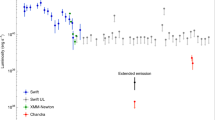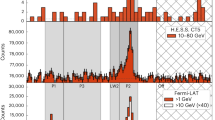Abstract
THERE is a change in the X-ray spectral index of the Crab pulsar NP0532 near 10 keV (refs 1 and 2). We here examine this in a more quantitative fashion than before, using most of the available published data, together with some unpublished data (Table 1). The pulsed fraction is the ratio of the pulsed radiation to total radiation; data published as the ratio of the pulsed to unpulsed components have been duly corrected. The unpulsed reference level has been determined according to Ducros et al.3 and where other workers have used a significantly different convention, these data have been corrected. We believe that all data (31 points), can be validly compared. Other results, not considered here2,4,5, are generally in agreement with the data we have used. The use of the pulsed fraction as the basic spectral quantity allows the low energy spectrum to be treated independently of interstellar absorption because it is the same for both the pulsed and unpulsed components.
This is a preview of subscription content, access via your institution
Access options
Subscribe to this journal
Receive 51 print issues and online access
$199.00 per year
only $3.90 per issue
Buy this article
- Purchase on Springer Link
- Instant access to full article PDF
Prices may be subject to local taxes which are calculated during checkout
Similar content being viewed by others
References
Fritz, G., Meekins, J. F., Chubb, T. A., and Friedman, H., Astrophys. J. Lett., 164, L55–L60 (1971).
Laros, J. G., Matteson, J. L., and Pelling, R. M., Nature phys. Sci., 246, 109–111 (1973).
Ducros, G., Ducros, R., Rocchia, R., and Tarrius, A., Nature, 227, 152–154 (1970).
Rappaport, S., Bradt, H., and Mayer, W., Nature phys. Sci., 229, 40–42 (1971).
Smathers, H. W., Chubb, T. A., and Sadeh, D., Nature phys. Sci., 232, 120–121 (1971).
Draper, N. R., and Smith, H., Applied Regression Analysis, Chapter 10 (Wiley, New York, 1966).
Cline, D., and Lesser, P. M. S., Nucl. Instrum. Meth., 82, 291–293 (1970).
Fishman, G. J., Hardnen, F. R., Johnson, W. N., and Haymes, R. C., Astrophys. J. Lett., 158, L61–L64 (1969).
Naranan, S., and Shah, G. A., Nature, 225, 834–836 (1970).
Shklovsky, I. S., Astrophys. J. Lett., 159, L77–L80 (1970).
Slysh, V. I., Nature, 224, 159–160 (1969).
Garmire, G., and Riegler, G. R., Astr. Astrophys., 21, 131–138 (1972).
Bradt, H., Rappaport, S., Mayer, W., Nather, R. E., Warner, B., MacFarlane, M., and Kristian, J., Nature, 222, 728–730 (1969).
Boldt, E. A., Desai, N. D., Holt, S. S., Serlemitsos, P. J., and Silverberg, R. F., Nature, 223, 280–281 (1969).
Floyd, F. W., Glass, I. S., and Schnopper, H. W., Nature, 224, 50–51 (1969).
Boclet, D., Brucy, G., Claisse, J., and Durouchoux, Ph., Rocchia, R., Nature phys. Sci., 235, 69–72 (1972).
Author information
Authors and Affiliations
Rights and permissions
About this article
Cite this article
THOMAS, R., ROTHENFLUG, R. X-ray spectrum of NP0532. Nature 249, 812–814 (1974). https://doi.org/10.1038/249812a0
Received:
Revised:
Issue Date:
DOI: https://doi.org/10.1038/249812a0
Comments
By submitting a comment you agree to abide by our Terms and Community Guidelines. If you find something abusive or that does not comply with our terms or guidelines please flag it as inappropriate.



